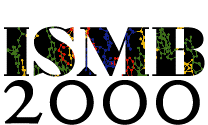35 - Study of the Structural Alignment of DNA Sequences over the Core Nucleosome Particle
Sreekala Balasubramanian, Wilma K. Olson, Rutgers University
We are studying the structural similarities in Protein-DNA complexes. Currently, we are analyzing the structural similarities in nucleosome positioning sequences using a computational technique called threading. We are looking for patterns in the DNA structure that might lead to nucleosome positioning and thereby come up with rules for nucleosome positioning.
36 - Sequence Analysis by Additive Scales: A General Framework and its Application to DNA Structure
Pierre Baldi, Pierre-Francois Baisnée, University of California, Irvine
Motivated by the analysis and prediction of DNA structure, we develop a framework for the computational analysis of sequences by additive scales. The framework is used to determine extremal sequences, inter-scale correlations, and to mine large data sets. It is applied to DNA structural scales and tandem repeats.
37 - Dynamics of DNA Depends on Conformation: An Implied Communication Network
T. C. Bishop, Tulane University and Xavier University of Louisiana; Y. M. Shi, J. E. Hearst, University of California, Berkeley
A continuum model describing DNA structure and dynamics has been developed. It is based on elastic rod theory and predicts a conformational dependence of the response of DNA to an external impulse. We propose that DNA binding proteins exploit this phenomenon to achieve signaling through the DNA.
38 - A Model for the Synchronization of Leading and Lagging Strand DNA Synthesis
William R. Cannon, Pacific-Northwestern National Laboratory
DNA replication: the recycling mechanism of the lagging strand polymerase from the end of an Okazaki fragment to the primosome is unknown. A simple diffusion simulation model is not only consistent with available data, but the data that was used for evidence for mechanical recycling was misinterpreted.
39 - Folding Space Alegras for RNA Structure Exploration
Dirk Evers, Bielefeld University, Germany
A new approach to the systematic development of dynamic programming algorithms is presented and applied to RNA folding. We demonstrate the method by deriving the recurrences for the complete suboptimal folding algorithm of Wuchty et al. and providing counting and free energy evaluation algebras, thereby extending the algorithm to correctly deal with dangling end contributions.
40 - Dynamics of DNA Slippage: Driven Bulge Loop Diffusion
Ulrich Gerland, Terence Hwa, University of California, San Diego
We investigate the dynamics of bulge loop creation and diffusion in double-stranded DNA theoretically, and propose to probe it experimentally by pulling the two strands apart at opposite ends. This mechanism is thought to be responsible for the occurence of indels during the replication of repeat regions in the genome.
41 - Automated Structural Alignment of a Hairpin Region in Archaeal SSU rRNA
J. Gorodkin, University of Aarhus, Denmark; S. L. Stricklin, G. D. Stormo, Washington University Medical School
The FOLDALIGN method presented here uses a combination of structure and sequence information to automatically produce alignments with approximately the same score as those published in the SSU rRNA database. We also show that FOLDALIGN complements stochastic context-free grammar (SCFG)-based detection of covariance, given sequences that do not align well globally.
42 - DNA Curvature in Whole Genomes
Ruy Jáuregui (Sandoval), Enrique Merino, Instituto de Biotechnologia-UNAM
The advent of new DNA sequencing technologies opens the possibility to make broad spectrum analysis of DNA curvature profiles in complete genomes. The nonfortuitous nature of DNA curvature and its relationship with codon usage and aminoacid composition of proteomes is here studied.


